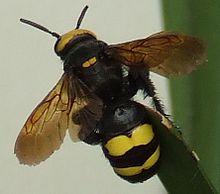
The Scoliidae, the scoliid wasps, are a family of about 560 species found worldwide. They tend to be black, often marked with yellow or orange, and their wing tips are distinctively corrugated. Males are more slender and elongated than females, with significantly longer antennae, but the sexual dimorphism is not as apparent as in the Tiphiidae.

Wasps in the family Pompilidae are commonly called spider wasps, spider-hunting wasps, or pompilid wasps. The family is cosmopolitan, with some 5,000 species in six subfamilies. Nearly all species are solitary, and most capture and paralyze prey, though members of the subfamily Ceropalinae are kleptoparasites of other pompilids, or ectoparasitoids of living spiders.

Dynastinae or rhinoceros beetles are a subfamily of the scarab beetle family (Scarabaeidae). Other common names – some for particular groups of rhinoceros beetles – include Hercules beetles, unicorn beetles or horn beetles. Over 1500 species and 225 genera of rhinoceros beetles are known.

The European beewolf, also known as the bee-killer wasp or the bee-eating philanthus, is a solitary wasp that lives in the Western Palearctic and Afrotropics. Although the adults of the species are herbivores, the species derives its name from the behaviour of the inseminated females, who hunt Western honey bees. The female places several of its paralysed prey together with an egg in a small underground chamber, to serve as food for the wasp larvae. All members of the genus Philanthus hunt various species of bees, but P. triangulum is apparently the only one that specialises in Western honey bees.

Cotinis nitida, commonly known as the green June beetle, June bug or June beetle, is a beetle of the family Scarabaeidae. It is found in the eastern United States and Canada, where it is most abundant in the South. It is sometimes confused with the related southwestern species figeater beetle Cotinis mutabilis, which is less destructive.
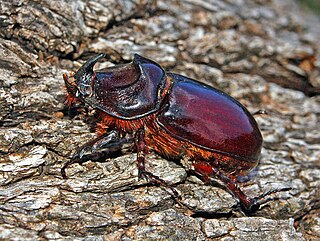
The European rhinoceros beetle is a large flying beetle belonging to the subfamily Dynastinae.

A wasp is any insect of the narrow-waisted suborder Apocrita of the order Hymenoptera which is neither a bee nor an ant; this excludes the broad-waisted sawflies (Symphyta), which look somewhat like wasps, but are in a separate suborder. The wasps do not constitute a clade, a complete natural group with a single ancestor, as bees and ants are deeply nested within the wasps, having evolved from wasp ancestors. Wasps that are members of the clade Aculeata can sting their prey.

Megascolia procer, the giant scoliid wasp, is a solitary wasp in the family Scoliidae found across Asia. It is one of the largest wasps in the world, with a wingspan of 11.6 cm (4.6 in).

Dinocampus coccinellae is a braconid wasp parasite of coccinellid beetles, including the spotted lady beetle, Coleomegilla maculata. D. coccinellae has been described as turning its ladybird host into a temporary "zombie" guarding the wasp cocoon. About 25% of Coleomegilla maculata recover after the cocoon they are guarding matures, although the proportion of other ladybird species which recover is much lower.

Scolia dubia, also known as the two-spotted scoliid wasp or a blue-winged scoliid wasp, is a species in the family Scoliidae.

Mutilla europaea, the large velvet ant, is a species of parasitoid wasps belonging to the family Mutillidae. It is a parasitoid on various species of bumblebees and is found in Europe, Asia, and North Africa.

Hemipepsis ustulata is a species of tarantula hawk wasp native to the Southwestern United States. Tarantula hawks are a large, conspicuous family of long-legged wasps that prey on tarantulas. They use their long legs to grapple with their prey before paralyzing them with a powerful sting. Their stings are ranked as some of the most painful in the insect world according to the Schmidt sting pain index. They are solitary, displaying lekking territorial behavior in their mating rituals.
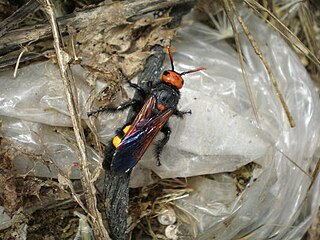
Megascolia is a genus of large solitary wasps from the family Scoliidae, the species classified under Megascolia include some of the world's largest wasps. They are parasitoids of large Scarabeid beetles such as the European rhinoceros beetle Oryctes nasicornis and Atlas beetle Chalcosoma atlas.

Pison spinolae, commonly known as mason wasp, is a solitary wasp of the family Crabronidae, found throughout New Zealand.
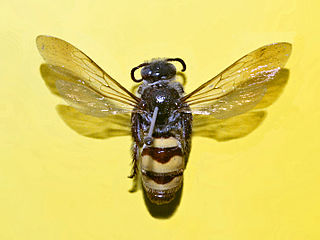
Dielis is a New World genus of the family Scoliidae, also known as the scoliid wasps.

Pygodasis is a New World genus of wasps in the family Scoliidae.
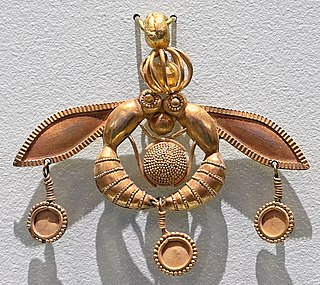
The Malia Pendant is a gold pendant found in a tomb in 1930 at Chrysolakkos, Malia, Crete. It dates to the Minoan civilization, 1800-1650 BC. The pendant was excavated by French archaeologists and was first described by Pierre Demargne. The pendant is commonly called "The Bees of Malia."

Campsomeriella thoracica is a species of scarab parasitoid wasp that has been recorded in the Middle East, Mediterranean, and Sub-Saharan Africa.

Dielis plumipes, the feather-legged scoliid wasp, is a species of scoliid wasp in the family Scoliidae.

Dielis tolteca, the Toltec scoliid wasp, is a species of hymenopteran in the family Scoliidae. It is commonly found on plants in the genus Solidago.
